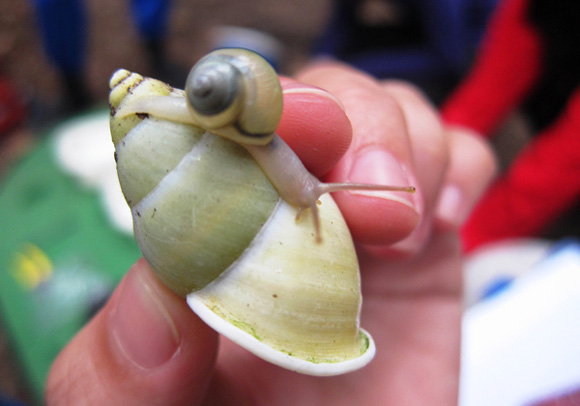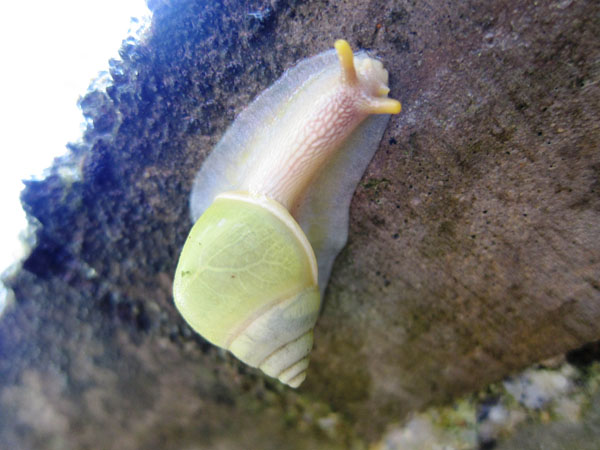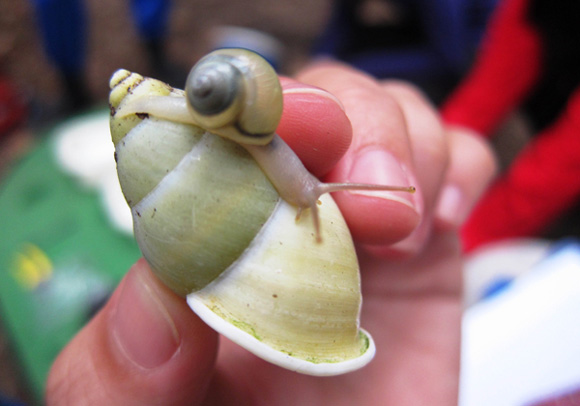Conserving The Singapore Green Tree Snail

A true blue Singaporean – the Green Tree Snail.
You probably have encountered snails in our parks, gardens, and even in the grass patches around your home. However, did you know that there are also many species of snails that live in our forests and other nature areas?
One such snail is the Singapore Green Tree Snail, Amphidromous atricallosus temasek. The Singapore Green Tree Snail is found solely in undisturbed forested area and is endemic to Singapore. This means that it exists nowhere else in the world except Singapore!
A denizen of the canopy
The Singapore Green Tree Snail has long been confused with another subspecies Amphidromous atricallosus perakensis which is widely distributed in Peninsular Malaysia. It was only in 2011 that the Singapore Green Tree Snail was recognised as a different subspecies by Mr Tan Siong Kiat, the curator for malacofauna at the Lee Kong Chian Natural History Museum and two of his colleagues.

Mummy and baby Green Tree Snail?
The Singapore Green Tree Snail can be easily recognised by its very distinct jade green shell and pale body. The green shell is very effective in camouflaging and to spot one of them in the forest requires very good eyesight and a tremendous amount of patience! It also prefers to live within the tree canopy and rarely comes down to the ground.
Its diet remains a mystery but many researchers speculate that it may feed mainly on fungi, lichens and detritus. Singapore Green Tree Snails are also known to be hermaphroditic, which means that a single individual possesses both male and female reproductive organs! However, they still need to find another snail to mate.
Threats faced
Over the years, due to rapid urbanisation, loss of habitat and exploitation by shell collectors, the population of the Singapore Green Tree Snail has declined to a point where it is now listed in the Singapore Red Data Book as an endangered species. Its population is now restricted to certain parts of the Central Catchment Nature Reserve and some of the offshore islands.
Conserving our natural heritage
In order to better understand and conserve the remaining populations of the Singapore Green Tree Snail, the National Parks Board has embarked on a 2-year study of land snail biodiversity in Central Catchment Nature Reserve. The study aims to assess the population and distribution of all land snails in Central Catchment Nature Reserve, including the Singapore Green Tree Snail.
The study also aims to identify any threat and propose preventive measures to ensure their survival within the forest. Preliminary results show that a healthy population still thrive within Central Catchment Nature Reserve.

Green Tree Snail feeding on algae.
The Singapore Green Tree Snail is an important natural heritage, and we should protect it for our future generations to appreciate. We can all do our part by preserving its natural habitat and refrain from collecting its beautiful shell.
Text by Lim Weihao & Li Tianjiao
Top photo of Green Tree Snail by Dr Cai Yixiong
Remaining photos by Lim Weihao.
Glossary:
Malacofauna: Invertebrate animal belonging to a group (phylum) known as Mollusca. It refers to animal such as snail, clam, octopus and many more.
Have views or comments on this article? Let us know via this form. If you would like to give us feedback on any other areas relating to our parks and gardens, please submit via https://www.nparks.gov.sg/feedback




Alan OwYong 11/23/2015 11:20:56 PM